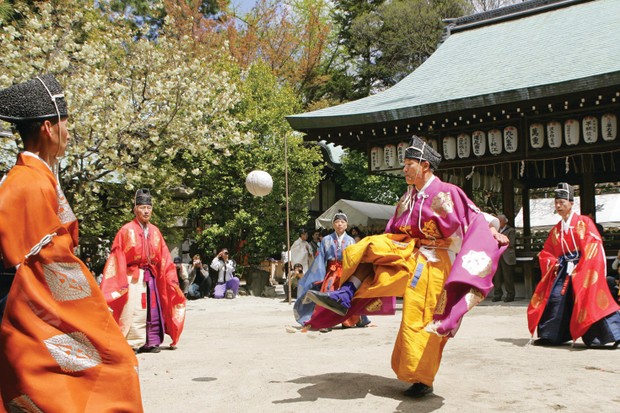- Name of sport (game): Kemari
- Name in native language: 蹴 鞠
- Place of practice (continent, state, nation):
Japan
- History:
The first evidence of kemari was found in the city of Nara (a former capital city) and dates from around 644 AD. It has been recorded in the Nihon Shoki, an ancient historical chronicle. (documents dating back to the Taika Reform). From 1192 till 1333 the game was a popular sport amongst samurai. The rules were standardized from the 13th century. The game was influenced by the Chinese sport of Cuju (the very earliest form of football). The characters for Kemari are the same as Cuju in Chinese. The sport was introduced to Japan about 600, during the Asuka period. Nowadays, it is played in Shinto shrines for festivals. It actually became a compulsory game for the court nobles during the Heian Period. By the Edo era (1603 – 1867), the game’s popularity had extended beyond the samurai to also include townspeople and wealthy landowners: Kemari had become a sport of mass appeal.
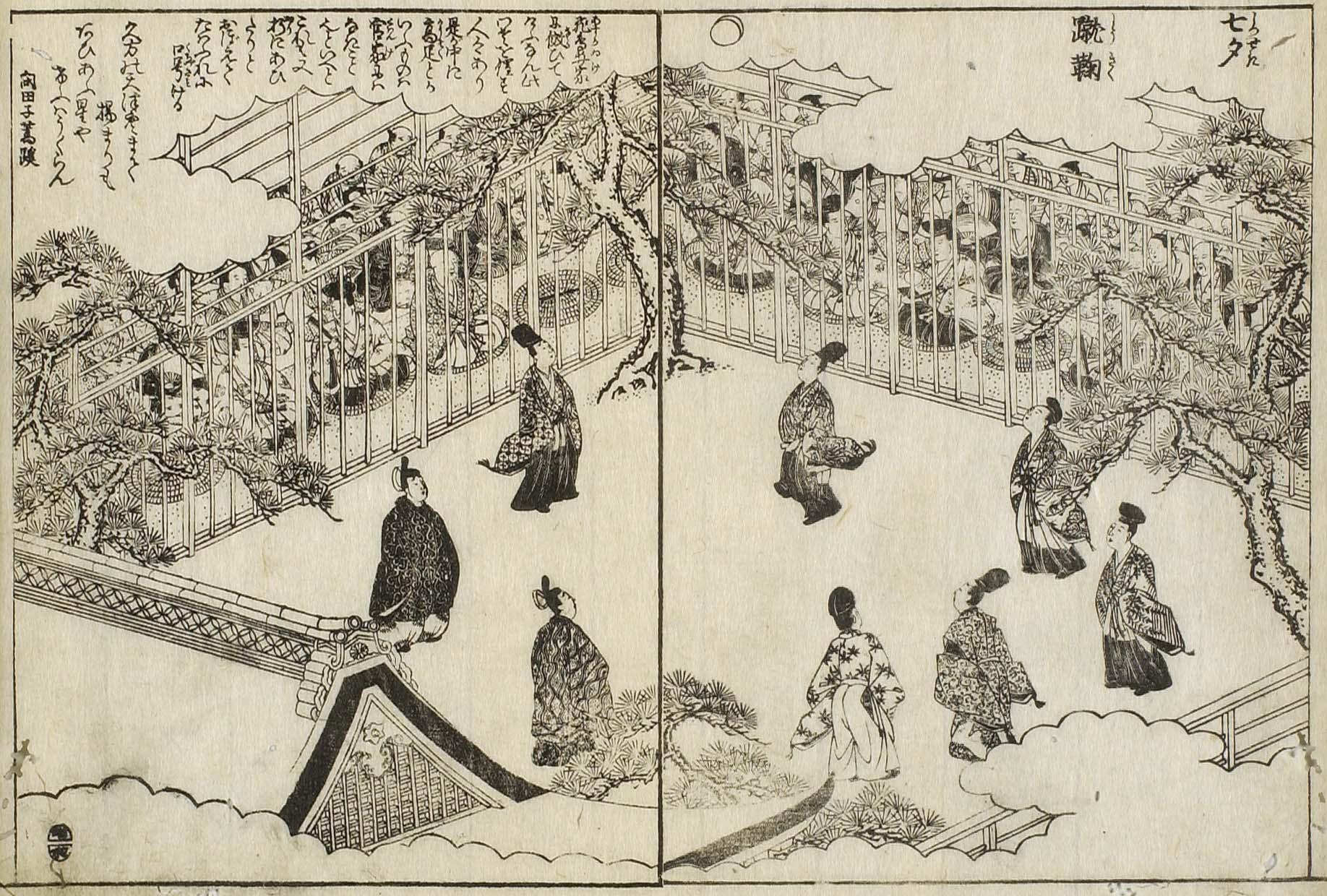 A work by Ritō Akizato from 1799 depicting a kemari game during Tanabata
A work by Ritō Akizato from 1799 depicting a kemari game during Tanabata - Description:
It is a non-competitive sport. The object of Kemari is to keep one ball in the air, with all players cooperating to do so. Players may use any body part with the exception of arms and hands – their head, feet, knees, back, and depending on the rules, elbows to keep the ball aloft. The ball, known as a mari, is made of deerskin with the hair facing inside and the hide on the outside. The ball is stuffed with barley grains to give it shape. When the hide has set in this shape, the grains are removed from the ball, and it is then sewn together using the skin of a horse. The one who kicks the ball is called a mariashi. A good mariashi makes it easy for the receiver to control the mari, and serves it with a soft touch to make it easy to keep the mari in the air.
The ball, known as the ‘mari’, weighs 130 grams and is 8 inches in diameter.
Kemari is played on a flat ground, about 6–7 meters squared. The uniforms that the players wear are reminiscent of the clothes of the Asuka age and include a crow hat. This type of clothing was called kariginu and it was fashionable at that time.
Particular clothing requirements applied to the higher nobility, who wore formal headgear, colourful kimonos and special shoes that may have been the precursors of today’s modern football boots. During the Kamakura period, Kemari was very popular amongst the samurai and it became deeply embedded in the warrior culture.
However, by the middle of the 19th century it had, for unknown reasons, lost its appeal to the general public, much to the displeasure of Emperor Meiji, who hoped to keep Japan’s noble court traditions alive by founding the Kemari Preservation Association.
Some rituals include placing the ball in the forks of the trees while saying one’s prayers in front of an altar.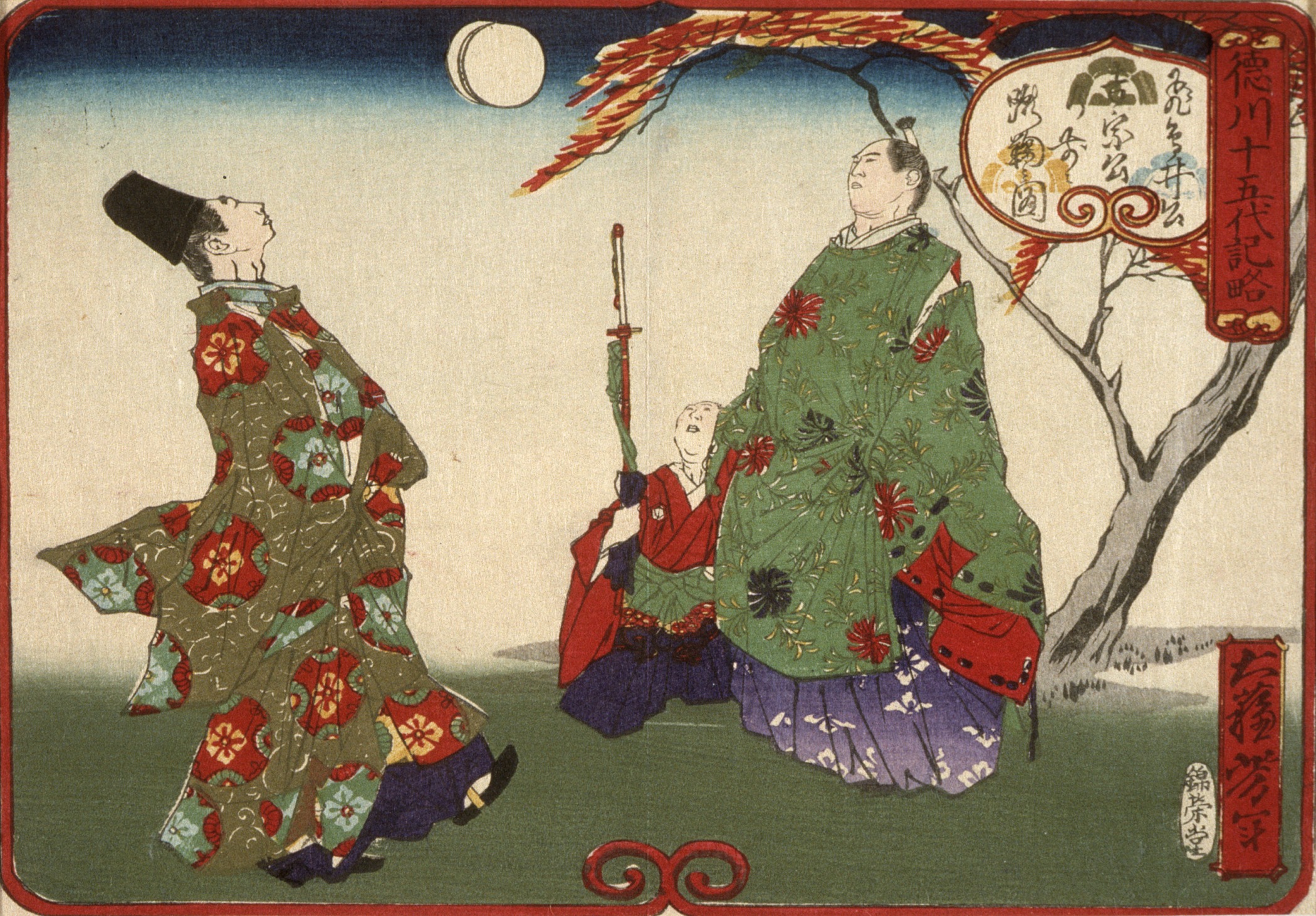 Tsukioka Yoshitoshi (Japan, 1839-1892), Tokugawa Yoshimune Playing Kemari
Tsukioka Yoshitoshi (Japan, 1839-1892), Tokugawa Yoshimune Playing Kemari - Current status:
Today, the tradition of Kemari is kept alive through two special events; the New Year celebration of “Kemari hajime” (first kick) in the “Shimogamo Jinja”, a Shinto shrine, and the annual Kemari festival, held each November in the ancient Japanese capital Nara ("Danzan jinja").
 Source: http://www.lizadalby.com/LD/TofM_games_files/kemari_game.jpg
Source: http://www.lizadalby.com/LD/TofM_games_files/kemari_game.jpg - Sources of information :
Allen Guttmann, Lee Austin Thompson, Japanese sports: a history. University of Hawaii Press, 2001
Richard Witzig, The Global Art of Soccer. CusiBoy Publishing, 2006Articles:
http://www.asahi.com/ajw/articles/AJ201812160008.htmlVideo:
https://www.youtube.com/watch?v=1MGp_sQHQLc
https://www.youtube.com/watch?v=sazlDB5QB60
https://www.youtube.com/watch?v=C4KLRts1H_k
https://www.youtube.com/watch?v=UR-PU-H9OSU
https://www.youtube.com/watch?v=hXimyyx8520Sources of photo in article and in gallery:
https://pl.wikipedia.org/wiki/Kemari
http://japoland.pl/blog/kemari-to-japonska-odmiana-pilki-noznej/
https://pl.wikipedia.org/wiki/Plik:Tokugawa_Yoshimune_Playing_Kemari_LACMA_M.84.31.333.jpg
https://wiadomosci.wp.pl/kemari-pierwsza-rytualna-gra-w-pilke-6038674344944769g/5
https://mlodytechnik.pl/eksperymenty-i-zadania-szkolne/wynalazczosc/29742-gra-w-pilke
https://commons.wikimedia.org/wiki/File:Kemari_Matsuri_at_Tanzan_Shrine_1.jpg
http://www.greentour-kyoto.net/events/kemari-hajime-event/
http://www.lizadalby.com/LD/TofM_games_files/kemari_game.jpg - Gallery:
- Name of sport (game): Kendo
- Name in native language: 剣道
- Place of practice (continent, state, nation):
Japan, practiced worldwide
- History:
Kendo is a martial sport derived from martial art – combat fencing called kenjitsu. Kenjitsu had been practiced in Japan since the introduction of a single-edged sword with a curved shape in the XI-th century. Many schools and various forms of Kenjitsu had been created before the swordsmanship lost its practical character in the second half of the nineteenth century. In 1868, civilians in Japan were banned to carry swords by an imperial edict, and in consequence swords stopped to be used for armed combat and duels. The origins and historical development of real fencing art are described in detail on the pages entitled kenjutsu and iaido.
The para-sport form of combat fencing was born in the early XVII century. Devices allowing infliction of blows were gradually introduced to the practice of fencing. This allowed a practice of contact technique and bloodless fights. The sharp steel swords used before only allowed repeating formalized routines called “kata”, in which blows were stopped in the final phase of the attack. The use of training swords, first wooden, later flexible bamboo structures, and solid protectors inspired by Samurai armor, allowed a more dynamic practice and fight sparring.
Chuta Nakanishi, creator and teacher of the well-known Tokyo fencing school- Nakanishi Itto-ryu, made the greatest contribution to the construction of safe equipment and its popularization among the practitioners. Master Nakanishi is also considered the creator of the name "kendo", where “ken” means "sword", while “do” indicates "way, procedure". Both Japanese characters should, therefore, be understood as "the way of the sword".
Over time, regulations were introduced to the practice, which gradually evolved towards limiting the acceptable area of cutting, as well as eliminating techniques that might cause risk for the fencers.
When the imperial act forbidding the swords and eliminating the social class of bushi warriors was introduced it seemed that the art of sword fighting would completely lose its practical value. It resulted in a decline of kendo popularity for a short period of time. After 250 years of voluntary isolation, the country was forced to open its borders and to confront foreign powers. Japanese society, having recovered from the initial amusement with the technical achievements of the world of that time, felt the danger threatening it and quickly returned to the traditional values. One of them was kendo, not in a military sense, but as a way of education through hard training and self-discipline. The kendo practice was first introduced in police forces, then gradually expanded.
Dai Nippon Butokukai - an organization aimed at reconstructing and taking care of traditional martial arts was established in 1895. A unification of very diverse forms and development of universal practice was required. Kendo was unified in 1912 which allowed its introduction to the curricula as a part of physical education class. Within a short time kendo training and tournaments spread throughout the country. These years are considered to be the birth time of the modern sport of kendo.
The samurai sword - katana - had been used much longer as a military symbol. Until the first decades on 20th century it was still considered an adornment and privilege of the officer's status, similarly as it was in many other armies of the world. However, only the Japanese made real use of their swords. The fact that swords were used not only for seppuku (ritual suicide) but also for the execution of prisoners of war, has earned the Japanese fencing a very negative opinion worldwide.
During the American occupation the Japanese were banned from practicing any of the traditional martial art since they were perceived as a source of Japanese chauvinism. Only after a dozen of years it was possible to convince the world’s public oppinion that modern sport version of Japanese martial arts had features allowing versatile physical development as well as outstanding moral and educational qualities. In 1952 kendo exercises were reintroduced in the school program, first in a pure sports version of shinai kyogi, later enriched with elements of traditional fencing. In the 1950s and 1960s, kendo appeared in the USA, Canada and Brazil thanks to Japanese emigrants. In the mid-1960s it came to Europe, firstly to France, Germany and Great Britain.
The first major international tournament took place in Tokyo in 1967. Two years later the European Kendo Federation was founded. The International Kendo Federation, a union of 15 organizations from all over the world, was founded in 1970. Kendo was brought to Poland in 1973 by a Japanese student, Takao Mizushima. In the Millennium Year 2000, IKF (the International Kendo Federation) brought together nearly 40 countries. The world championships (every 3 years) and the European championships are held. Nowadays kendo is considered a modern international sport discipline.
(Source: Polish Kendo Association: www.kedno.pl) - Description:
Kendo (the way of sword) is a Japanese variation of fencing sport practiced with a bamboo sword. This movement has a centuries-old tradition in Japan. At the beginning of the twentieth century it became well known worldwide thanks to the Japanese emigrants. It became popular in Europe and in Poland in the second half of the twentieth century.
Clear definition of goals is a characteristic kendo feature. This allows the practice of kendo could last for a lifetime and it have impact on all aspects of human psyche. The fight (competition) is not the purpose of the practice but a way to shape the personality. A very concise definition of this discipline has been created: Kendo is a way to strengthen one’s character by applying the rules of sword fighting.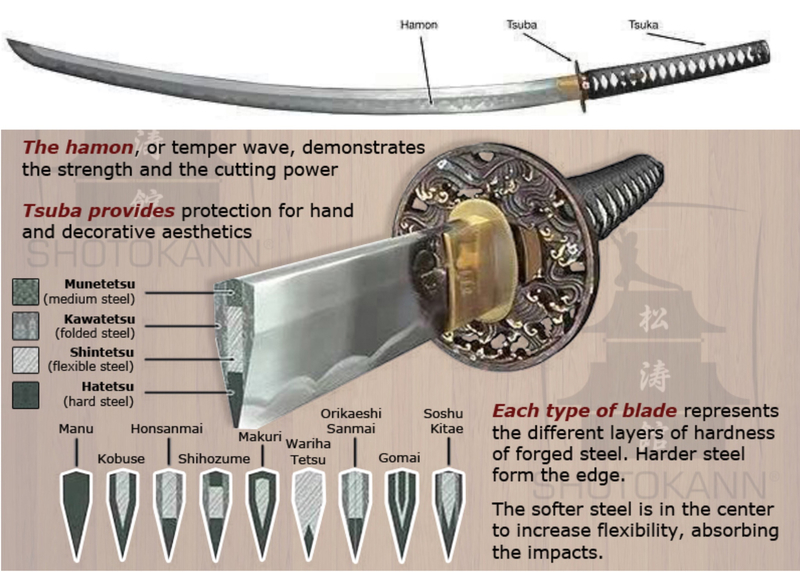
The All Japan Kendo Federation described the purpose of practice as follows: "Everyone should practice kendo in a conscious and sensible way, shape the mind, spirit and body through accurate and rigorous training, respect others and remember to be polite, honest and honorable. This is the constant development of the human character - because only then can you truly love your nation and your homeland, take care of the development of the society and strengthen peace and prosperity all over the world."
Learners are prepared for the contact fencing fight during the training. The rules of this fight are created to protect the fighters from the injuries. Additionally, solid protectors, expressly designed for the purpose of protecting the body from injuries, are used. Secondly, the hit area (cuts and thrusts) is limited to a few areas, like head, forearm, torso, and neck, covered by protectors. Thirdly, the method of points calculation for the hit and the behavior of players during and after the attack is meant to secure the safety of the fencers This way accidents are avoided but the spontaneity of the attack is not limited. Young players (up to 16 years old) are forbidden to use a thrust in the protected neck area.
The training and fight are regulated by a special code of ethics, which controls the behavior and guarantees the safety of the fencers. Learning of the technique and tactics of the fight is quite difficult due to the direct and full-contact attack. It requires a lot of attention and effort from the learners and proper practice organization from the instructor. As a result, kendo training is held under direct and permanent control of the instructor and all parts of the training are preceded by appropriate commands in Japanese. The use of Japanese nomenclature generalizes the message and enables smooth communication during international trainings and competitions, at the same time being a nod to the kendo homeland.
Importantly, kendo is a coeducational sport, which can be practiced together by men and women. The success in competition depends on the technical skills of the fencer, not on their physical strength. Kendo, like the European fencing, allows a very dynamic fight without a risk of injury. A study conducted at the Imperial University of Kyoto in 1992, revealed that kendo is one of the sports with the lowest contusion rate.
Kendo is practiced by circa 6 million of people, 3.5mln of which outside of Japan, mainly in the USA and Europe. Kendo is a sport which can be practiced regardless of age, sportsmanship and gender.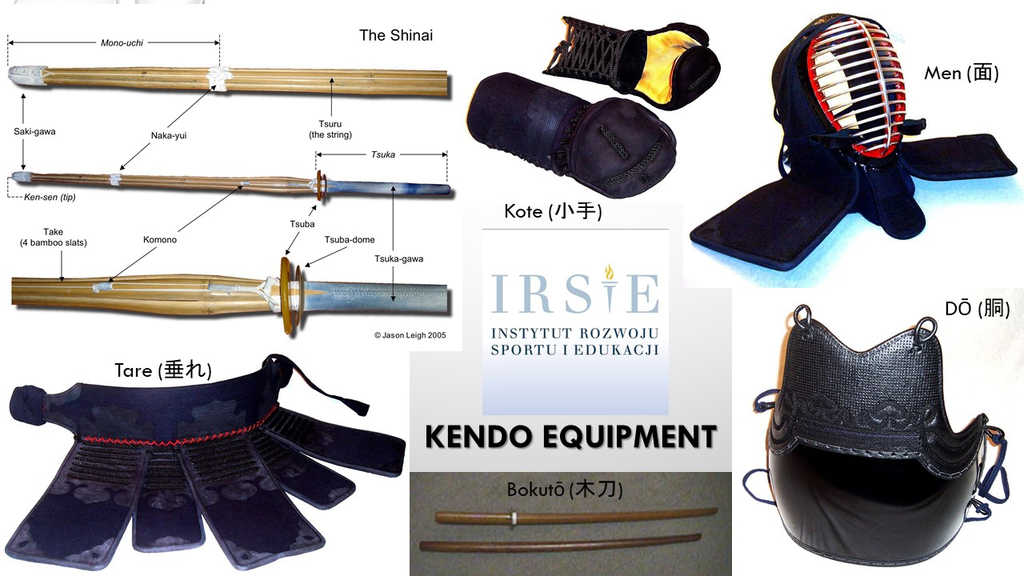
- Current status:
Sport practiced
Despite its strong national roots, kendo is nowadays an universal sport discipline known worldwide. European Kendo Federation (EKF) was established in 1969 while the International Kendo Federation (IKF) - bringing together 50 countries, has been operating since 1970. In Poland kendo has existed since 1973. Currently under the aegis of Polish Kendo Association there are about 800 learners of kendo, iaido and jodo in forty-two clubs (dojo). - Importance (for practitioners, communities etc.):
Ozawa Hiroshi - Kendo, Diamond Books, Bydgoszcz 2000
Paul Budden - Nihon kendo kata, Diamond Books, 2003
Jinichi Tokeshi - Kendo. Elements, rules and philosophy , Diamond Books, 2008
All Japan Kendo Federation (ZNKR) - Fundamental Kendo, Japan Publications, Tokyo 1974
All Japan Kendo Federation (ZNKR) - Kendo Fundamentals, Vol.1 - Kendo equipment, courtesies, basic movements, etc., Tokyo 1994
All Japan Kendo Federation (ZNKR) - Kendo Fundamentals, Vol.2 - Personal attack and defense skills, Training Methods, etc. Tokyo 1994
All Japan Kendo Federation (ZNKR) - Japanese-English Dictionary of Kendo, Tokyo 1996
Toshinobu Sakai - A Bilingual Guide to the History of Kendo, Toshinobu Sakai and Alexander Bennett NP, 2010 - Contacts:
Polish Kendo Association - http://www.kendo.pl
The European Kendo Federation - http://www.ekf-eu.com
International Kendo Federation - http://www.kendo.or.jpPrepared by: Włodzimierz Małecki
The information of the Polish Kendo Association was also used - Sources of information :
- Gallery:
- Name of sport (game): Kenjutsu
- Name in native language: 剣術
- Place of practice (continent, state, nation):
Japan
- Name of sport (game): Khiva
- Place of practice (continent, state, nation):
Turkmenistan
- Name of sport (game): Kho Kho
- Name in native language: Punjabi: ਖੋ-ਖੋ
- Place of practice (continent, state, nation):
India, Bangladesh, Pakistan, Sri Lanka, Nepal, Maldives, Japan, South Africa
- History:
Kho Kho is a traditional sport from the Indian subcontinent. This sport appeared long ago in Pune Gymkhana the state Maharashtra. Together with kabbadi, it’s one of the two most popular traditional sports in South Asia.
It was played on chariots called Rath. In its ancient form, the game was known as Rathera.
It was a very popular sport, and for many years practiced in an informal way. In order to popularize the game club, Deccan Gymkhana from Pune tried to formalize its rules.
The present appearance of the game was an adoption about the time of World War I in 1914. But at that time, there were neither any dimensions of the playground nor the poles which demarcate the central lane.Kho Kho is a tag game, it could also be called Game of hunting. Kho Kho is a traditional game played in India. Its origins are ancient, with strategies and tactics likely derived from the epic ‘Mahabharata’. On the 13th day of the war, the Kaurava General Guru Dronacharya created the ‘Chakravyuha’ a special military defensive circle which was eventually penetrated by the renowned warrior Abhimanyu. He was killed eventually by having to fight alone against 7 other warriors but he inflicted heavy casualties in return. His style of fighting reflects the concept of ‘ring play’ – a defensive tactic in Kho Kho. There are many other similarities. It has gradually become a favorite game of children and for many centuries served as entertainment.
Deccan Gymkhana Pune, a club created by the Indian leader Lokmanya Tilak, formalized the rules of the game for the first time. This initial stage marked the limitation of the playground and yet sadly lacked the poles demarking the central lane in the field. Instead, less experienced players were posted squatting at the ends of the latter and chasers ran around them to return to the midfield. In 1919, the Kho Kho game area was limited to 44 yards of the central lane length and 17 yards of the ellipse width.
The years 1923-24 saw the foundation of the Inter School Sports Organization and Kho Kho was introduced to develop at the grassroots and consequently popularize the sport.
Those efforts can be compared to those of Deccan Gymkhana and Hind Vijay Gmykhan. Other popular games like Langdi and Atya-Patya, allowed to practice similar skills as Kho Kho. Especially the latter game requires special mention, because it was well known, and important for Kho Kho, because it developed defense skills.Akhil Maharashtra Sharirik Shikshan Mandal (Institute of Physical Education) was founded in 1928 when Dr. Abasahib Natu Pune, Mahabal Guruji from Nasik, Karmarkar Vaidya from Miraj and Dr. Mirajkar Bombaju, in cooperation with Kho-Kho experts, formulated the rules and regulations of the game, which differed somewhat from the Federation regulations of nowadays.
Hind Vijay Gymkhana, Baroda and Deccan Gymkhana, Pune had their own rules that differed too. In 1933, experts from around sixty Gymkhanas gathered and developed a code of principles called Akhil Maharashtra Sharirik Shikshan Mandal which was acknowledged in 1935.
Over the years the rules have changed. Firstly, in 1914, 10 points were scored for each opponent and the round lasted nine minutes. In 1919, the score was reduced to 5 and the match lasted eight minutes. In the following years, points were also given as an early ending bonus. Further changes concerned the playing field, which was changed into a rectangle instead of an ellipse. The distance between the two ends was shortened to 27 yards, a free zone was created beyond the ends of the game rectangle 27 yards x 5 yards, also known as zone "D". In this zone, the hunter could move in any direction, regardless of the direction change.
Kho Kho was first presented in Berlin during the Olympic Games in 1936. The first national championship of India Kho-Kho was played in Vijay Wada, in the state of Andhra Pradesh, in 1959/60 under the auspices of the Federation of India Kho-Kho. The team lead from Bombay area won the competition. Rajabhau Jeste who led it was a champion of this game, an expert and commentator. First women’s championships were held in 1960/61.
In 1982, Kho-Kho was incorporated into the Indian Olympic Association and a few years later, in 1989 a show was held during the 'Asian Games' Festival. At that time, several changes were made to the game, accepted and included by the Asian Federation. The pillars were moved to a distance of 23.50 meters, and the square of the game was increased in width to 16 meters. The duration of the rounds was set at nine minutes.
First International Championships were organized in Kolkata in 1982.Kho-Kho can develop many desirable traits – sports competition, teamwork, loyalty, self-confidence, speed, agility, strategical thinking. Kho Kho is not only a sport with a lot of running and crouching, but it's also a great school of teamwork. Players must watch each other closely, cooperate, recognize situations and take decisions quickly. This sport has also a strategic dimension. Not only it shapes the body but also sharpens the mind
- Description:
Kho Kho is played by teams of 12 nominated players out of fifteen, of which nine enter the field who sit on their knees (chasing team), and 3 extra (defending team) who try to avoid being touched by members of the opposing team.
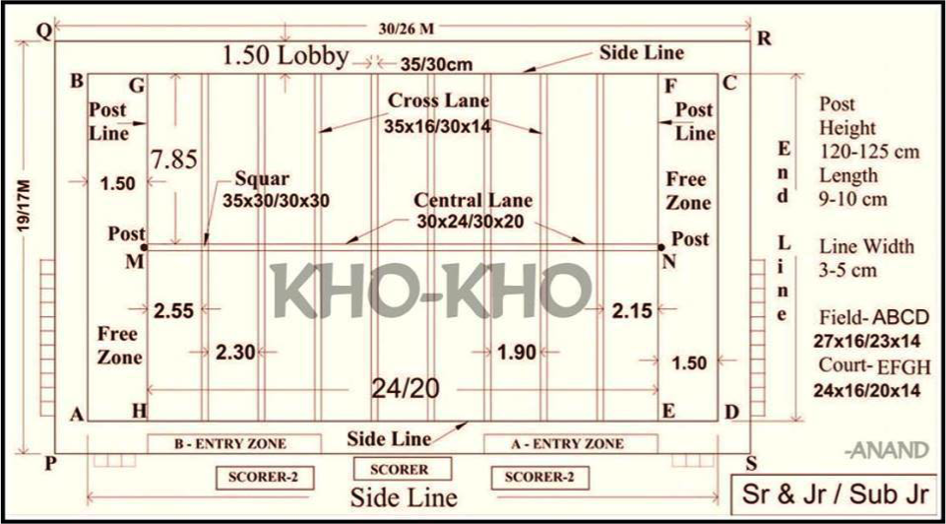
One team sits on their knees in the middle of the court, 8 in a row, with adjacent members facing opposite directions. One team sits or kneels in a row in the center of the field. The runners of play in the field, three at a time and the team that takes the shortest time to touch all the opponents in the field wins.The Kho Kho is played on a rectangular field, 30 meters long and 19 meters wide ( according to other sources: 27 meters long and 15 meters wide). There are two rectangles at the end. The length of this rectangle is 16 m and width is 2.75 (2.7 m). In the middle of these two rectangles, there are two wooden poles. The central path is 23.5 (21.60) long and 30 cm wide. There are eight transversal strips that lie across the central belt, their length is 16 (15) meters and width 30 cm. This makes small rectangles, each of them 16 meters long and 2.3 meters wide (two rectangles near wooden posts are 2.5 meters wide), which are perpendicular to the middle belt and evenly divided into two parts of 7, 85 (7.3) meters each. At the ends of the central path, there are two wooden posts, 120 cm high, permanently located. Their perimeter is between 30 and 40 cm. They are made of wood, smooth along the entire length, flat in the
upper part.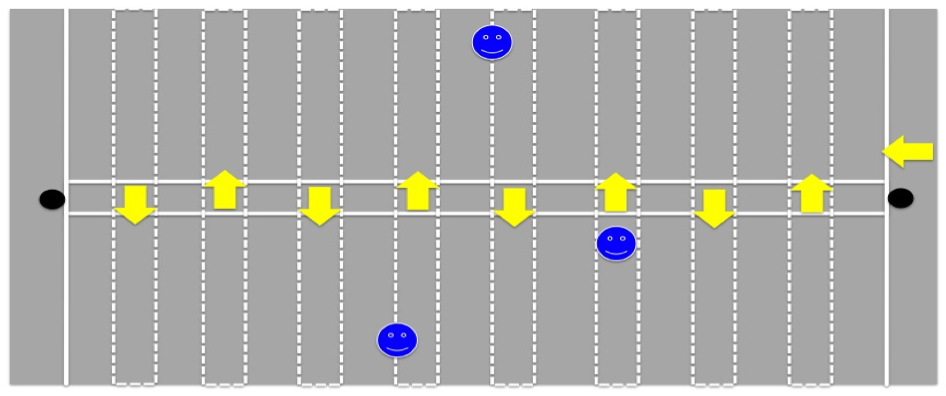
- Current status:
Sport practiced
Federation of India Kho-Kho (K.K.F.I.) is the most important association for this sport. It has branches in many countries and conducts Mini, Junior and open Championships for both genders in many parts of India.
The Kho-Kho Federation of India was founded in 1956 with modern game rules under the leadership of Lt. Bhai NERURKAR Maharashtra, Lt. Bhupati Mazumder, Lt. Sambhunath Mallik and Lt. Deben Bose West Bengal.
In 1959-60, the first Kho-Kho championship was organized in Vijayawada (Andhra Pradesh). Prizes were founded on the initiative of the government: Arjuna Award, Eklavya - men's prize, Rani Laxmi Bai - for women, Veer Abhimanyu - for boys under 18 years old and the Janaki award for girls under 16 years of age.In 1960, the Federation of India Kho-Kho began to promote the sport in schools, universities and clubs. In the same year, the first national competition Kho Kho was organized only for men in Vijayawada. Three teams participated. In 1961, a national competition for women was organized, in which four teams participated.
In 1963-64, to award best players Kho Kho, the Federation of India introduced a prize for the best player - EKALABYA for men and RANI JHANSI for women. The Kho Kho Federation began to organize the Junior National Championship for boys in 1970 and for girls in 1972. In order to encourage young people, an award for the best junior was founded - ABHIMANYU VEER for boys and JANAKI for girls. In 1980, the Junior category was introduced for boys and girls. BHARAT award for boys and ILA for girls were established.
As part of the Sports Authority of India, six-week training courses were introduced as part of this discipline. In 1977, the duration of the course was increased to 10 months. Since Kho Kho & Kabadi were connected, it was difficult to complete the Kho Kho course within 10 months. In 2008, a separate 10-month training course for Kho Kho trainers was established. In 1985, Kho Kho was included in the first National Competition held in Delhi, thanks to the personal efforts of Sri Ashok Ghosh, the President of the Bengal Olympic Association.
The Asian Kho Kho Federation was founded in 1987 during the third SAF Games competition in Calcutta, India. The Federation includes India, Bangladesh, Pakistan, Sri Lanka, Nepal and Maldives. The first Asian Championships took place in Calcutta in 1996 and the second in Dhaka in Bangladesh. The participants of the championships were India, Sri Lanka, Pakistan, Nepal, Japan, Thailand and Bangladesh.
- Contacts:
Kho Kho Federation of India - http://khokhofederation.in/
Kho Kho Federation of England: KKFE - http://khokho.co.uk/
Madhya Bharat KHO KHO - https://www.facebook.com/Madhya-Bharat-KHO-KHO-807347155952035/
KHO KHO Andhrapradesh - https://www.facebook.com/INDIANSPORTKHOKHO/?fref=pb&hc_location=profile_browser
Kho-Kho Clics - https://www.facebook.com/Kho-Kho-Clicks-679707098807875/?fref=pb&hc_location=profile_browser
KHO-KHO TEAM FROM TAMIL NADU - https://www.facebook.com/khokho.svm/
Kho Kho Federation of England - https://www.facebook.com/kho.england/
- Sources of information :
Video:
https://www.youtube.com/watch?v=kD-D6QWDn7k
2016 - South Asian Games - Kho-kho - Men's Group Match - India vs Nepal - https://www.youtube.com/watch?v=UodKkoktvUs
Senior kho kho national (baramati) kolhapur v/s maharashtra - https://www.youtube.com/watch?v=csSPTMImb6g
49th National Kho Kho Championship, Solapur - https://www.facebook.com/49th-National-Kho-Kho-Championship-2015-Solapur-1677540765814919/?fref=pb&hc_location=profile_browser - Gallery:
- Documents:
- Name of sport (game): Kochti persa
- Place of practice (continent, state, nation):
Iran

